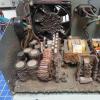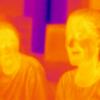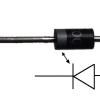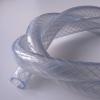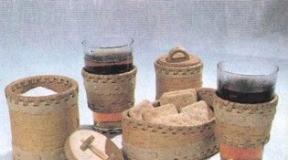What you need to know about infrared radiation? Infrared light - invisibly warm radiation workshop Infrared light properties
Food products can be affected by several types of electrophysical effects. This includes electric current, electric impulse, ultra-high frequency, ultraviolet and some others, including infrared radiation.
With the help of infrared radiation on products, the following technological processes can be carried out: heating, roasting, baking, drying, and others. When exposed to the material, or rather, its flow, it turns into heat. The ability of products to absorb infrared radiation is affected by two factors - the wavelength that affects the product and the optical properties of the product itself. The wavelength can have a value from 0.76 to 750 microns. Depending on the wavelength, there are three groups of its radiation ranges.
1) Shortwave. The wavelength is from 0.76 µm to 2.5 µm.
2) Medium wave. The wavelength is from 2.5 to 25 microns.
3) Longwave. The wavelength is from 25 to 750 µm.
There are also a number of coefficients that characterize the process of interaction of matter with the energy acting on it. These are the reflection coefficient, the coefficient of absorption and transmission. When food products are exposed to heat treatment, their surface changes its structure, color, etc., i.e., does not remain constant.
Sources of infrared radiation are divided into light and dark, depending on what wavelength they emit. Light emitters have a visible light region in their spectrum. The boundary between dark and light emitters is a wavelength of 3 microns or more.
The light sources of infrared radiation include the following types of emitters: electric and gas.
The main element of electric emitters is a wire consisting of nichrome or tungsten. Most often it is made in the form of a spiral.
Consider some types of electrical emitters in more detail.
A mirror lamp is a glass bulb with a tungsten filament placed in the center. The power of such a lamp can be 250 - 500 W, the emission spectrum lies in the range from 0.8 to 6 microns. They are capable of heating products up to 240 C. They are installed 15 cm from the surface of the products. This type of electrical emitters is quite fragile.
A tubular quartz lamp has a tungsten spiral inside, its output is molybdenum. Power is 920 - 1000 watts. The maximum wavelength is 1 µm. In order to reduce the process of evaporation of tungsten onto the inner surface of the tube as much as possible, an inert gas is pumped into it. These lamps are inertialess.
Open and closed. Their main element is a nichrome spiral. The wavelength is 2.4 µm and 2.5 µm, respectively.
Application of quartz glass tubes as IR emitters in the food industry prohibited by hygienic requirements, because they can be easily broken during operation of the equipment.
Also heating elements belong to electric infrared emitters. The emitted wavelength is 2.5 µm.
Gas infrared emitters, as their name implies, run on gas, it can be either natural or liquefied gas.
Which infrared source is required to process a particular product will depend on: the spectral characteristics of the product itself, how intensely the heat will be supplied and the efficiency of the apparatus.
1In 1666, Isaac Newton performed a famous experiment that contradicted almost all theories of color that existed at that time. He discovered the dispersion of sunlight as it passes through a triangular prism. It turned out that a white, colorless beam, refracted, becomes multi-colored like a rainbow. Today, even children know the magic phrase that helps to remember the order of the seven primary colors of the rainbow - from red to purple: "Every hunter wants to know where the pheasant sits."
But it took another hundred years before infrared (IR) rays were discovered in 1800 by the English physicist William Herschel. The reason is simple - IR rays are invisible to the human eye and are detected only indirectly, for example, increase the readings of a thermometer.
IR radiation is electromagnetic waves with a length of 770 nm to 1 mm. IR radiation obeys the laws of optics and therefore has the same nature as visible light. In 1923, the Soviet physicist A. A. Glagoleva-Arkadyeva received radio waves with a wavelength from 50 mm to 82 microns, lying in the gap between radio waves and infrared radiation. Thus, it has been experimentally proved that visible light, infrared radiation and radio waves have a common electromagnetic nature.
IR radiation is not visible to the naked eye. A person feels infrared radiation as heat. Therefore, all heated bodies are sources of infrared radiation. Since the person himself is a heated body, he also emits IR rays, which reduces his sensitivity to external IR radiation. Therefore, it is necessary to work on the creation of devices that have increased sensitivity and allow you to "see" or "hear" infrared radiation coming from bodies that are very slightly heated or very distant from us.
The relevance of the research work lies in the fact that all children have a problem when they need to understand something new, invisible and almost intangible. And all children like to play, so we decided to turn boring into interesting and exciting.
The object of study in this work are sources of infrared radiation.
The subject of the study is the properties of infrared radiation, which make it possible to make it tangible, visible or audible, and thereby arouse interest and captivate listeners.
The purpose of the research work is to reveal the properties of infrared radiation, which allow it to be used in technology and everyday life.
1. Study the sources of infrared radiation,
2. Find out their impact on a person,
3. Consider examples of use in technology and everyday life.
If there are sources of infrared radiation available to us, if it affects a person, if it is used in technology and in everyday life, then it is possible to develop games and exciting demonstrations that can arouse interest in the study of this amazing natural phenomenon.
Research methods: bibliographic analysis of literature and Internet materials; observation and photography; conducting experiments; synthesis of games and demonstrations.
The structure of the work is determined by the subject, purpose and objectives of the study. The work consists of an introduction, five sections and a conclusion.
The introduction gives an assessment of the current state of the problem being solved, reveals the relevance, defines the object, subject, goal, objectives and research methods.
The first section discusses various sources of IR radiation. The second section discusses the impact of infrared radiation on humans. The third section provides examples of the use of infrared radiation in technology and everyday life. The fourth section is devoted to the development of the Find Little Red Riding Hood game, which allows viewers to understand how the invisible can be seen. In the fifth section, a device is synthesized that demonstrates to listeners how invisible infrared radiation can be heard and allows them to hear what a clean and dirty liquid is and why it is necessary to wash their hands thoroughly.
In conclusion, the results of the study are summarized, final conclusions on the topic under consideration are formulated, directions for further research are indicated, and proposals are made for the practical use of the results obtained.
Sources of infrared radiation
A powerful source of infrared radiation is the Sun, about half of whose radiation lies in the infrared region. A significant proportion (from 70 to 80%) of the radiation energy of incandescent lamps with a tungsten filament is IR radiation. Therefore, when photographing in the dark and in some night vision devices, the backlight lamps are equipped with an infrared light filter that transmits only infrared radiation.
Artificial sources of IR radiation are:
Carbon electric arc with a temperature of about 3900 K, the radiation of which is close to that of a black body;
Various gas-discharge lamps (pulse and continuous burning);
Spirals made of nichrome wire, heated to a temperature of ~ 950 K. They are used for radiation heating of rooms. For a better concentration of infrared radiation, such heaters are equipped with reflectors. In scientific research, for example, when obtaining infrared absorption spectra in different regions of the spectrum, special sources of infrared radiation are used:
Tape tungsten lamps;
Nernst pin, which is a thin rod of various metal oxides, heated with an electric current. The rod contains oxides that have significant selective IR radiation, such as oxides of cerium, thorium, zirconium, etc. It is characterized by: stable operation, the absence of combustion products that can damage equipment, ease of use and intense radiation with wavelengths up to 15 microns;
Globar - a silicon carbide rod with a diameter of 5 mm and a length of about 40 m, heated by an electric current passed through it to a temperature of about 1400 ° C. Operating range of radiation from 0.8 to 25 microns;
High pressure mercury lamps;
Semiconductor IR diodes;
Optical quantum generators - lasers, the radiation of some also lies in the infrared region of the spectrum; for example, the radiation of a neodymium glass laser has a wavelength of 1.06 μm, a laser on a mixture of neon and helium - 1.15 μm and 3.39 μm, a carbon dioxide laser - 10.6 μm, an InSb semiconductor laser - 5 μm and others
IR receivers are based on converting IR energy into other types of energy that can be measured by conventional methods. There are thermal and photoelectric infrared radiation receivers. In the first, the absorbed IR radiation causes an increase in the temperature of the temperature-sensitive element of the receiver, which is recorded. In photovoltaic receivers, the absorbed infrared radiation leads to the appearance or change of an electric current or voltage. Photoelectric receivers, unlike thermal ones, are selective receivers, that is, they are sensitive only in a certain region of the spectrum. Special photographic films and plates - infraplates - are also sensitive to IR radiation (wavelength up to 1.2 microns), and therefore photographs can be taken in IR radiation. Charge-coupled devices (CCDs), which are one of the main elements of all digital cameras, have a certain sensitivity to infrared radiation. Using a mobile phone with such a digital camera, it is easy to register the radiation of the IR diode of the TV remote control (RC) and the reflection of this radiation from the mirrors.
If you use an IR light filter, then you can use the camera to observe the infrared radiation of highly heated bodies, for example, the Sun, the filament of an incandescent lamp.
Using an infrared telescope, you can see galaxies hidden from us by clouds of dust. This is how, for example, the Andromeda Nebula looks in IR rays. Substances transmit visible and IR radiation differently, for example, iodine greatly weakens visible light, and in the IR range it is almost transparent.
Human perception of infrared radiation
IR radiation is a naturally occurring form of radiation on Earth. A person is constantly exposed to infrared rays, this is his normal state. Most of the solar energy comes to Earth in the form of infrared radiation. The sun, which is at its zenith, provides illumination at sea level of just over 1 kW/m2. At the same time, 523 W falls on IR radiation, 445 W. - for visible light, 32 W. - for ultraviolet radiation. In addition, all other bodies consisting of charged particles that perform constant chaotic oscillations are also emitters of infrared rays in the wavelength range from 770 nm to 2 mm.
The wavelength of thermal radiation of the person himself is 9.6 microns. The human body produces an average of 100 kcal/hour of heat. This amount increases with an increase in metabolism, for example, during muscular work. How much heat the body produces, the same amount it must give to the environment. If it gives off more than it produces, then there is a danger of freezing; if it gives off too little, then heat stroke occurs.
The effect of infrared radiation on humans was studied by the Japanese physician Tadashi Ishikawa in the 60s of the last century. He found that infrared rays can penetrate the human body to a great depth, causing a similar effect that a person gets in a steam room. But in this case, sweating of the skin begins already at an ambient temperature of about 50 ° C and the internal organs warm up much deeper than in the steam room. Infrared waves, penetrating deep into the human body, warm up all its organs and increase blood circulation. Physical thermoregulation is rebuilt to increase heat transfer, while chemical thermoregulation leads to a decrease in heat production. Which leads to the expansion of the vessels of the skin, subcutaneous tissue and respiratory organs, which in turn improve muscle nutrition and dramatically increase the supply of oxygen to tissues. The result of these works was the creation of infrared cabins, in which long-wave IR heaters were the main heating element.
Long-term studies of scientists on the effect of infrared radiation on humans have shown that infrared heat has a positive effect on human health. At the same time, the radiation absorbed by the body warms the person, transforming into heat, and the excess heat is given off to cool air, acting refreshingly on it. But we should not forget that prolonged exposure to intense infrared radiation can provoke heat stroke, and exposure to very strong infrared radiation causes a feeling of pain and leads to burns.
Under normal (natural) conditions, a person does not see infrared radiation. But human interaction with artificial quantum sources of infrared radiation (lasers) made it possible to make an unexpected discovery. Under certain conditions, the human eye can see IR radiation.
The discovery was made by chance during an experiment related to another study. Scientists from Washington University in St. Louis noticed that they periodically see flashes of green light when using an IR laser, which surprised them very much.
The researchers then set up a series of tests. First - with volunteers who were shown flashes of an IR laser. It turned out that a person really, if the flash is short enough, is able to regularly notice it.
The scientists then irradiated mouse retinal cells with infrared radiation (they can't see it either), and also simulated the effects of infrared radiation on rhodopsin, the main light-sensitive protein in the retina.
It turned out that rhodopsin can perceive radiation in the near-IR range due to a quantum effect known as two-photon absorption.
When the intensity of laser radiation, that is, the number of photons that the laser emits per unit time, becomes sufficient, then rhodopsin can absorb two photons simultaneously. For example, if a protein absorbs two photons with a wavelength of 1000 nm, then the eye perceives them as a single photon with a wavelength of 500 nm, which corresponds to just green for the human eye.
The discovery, scientists believe, not only deepens modern ideas about human vision, but can also lead to improved methods for diagnosing eye diseases.
Examples of the use of infrared radiation in technology and in everyday life
IR radiation is widely used in scientific research, in solving a large number of practical technical problems, in military affairs, in human life.
The study of emission and absorption spectra in the infrared region is used to study the structure of the electron shell of atoms, to determine the structure of molecules, as well as for the qualitative and quantitative analysis of mixtures of substances of complex molecular composition, such as motor fuel. Due to the difference in the coefficients of scattering, reflection and transmission of bodies in visible and infrared radiation, a photograph obtained in infrared radiation (thermography) has a number of features compared to ordinary photography. For example, infrared images often show details that are not visible in normal photography.
Infrared images are also widely used in astronomy, along with other types of electromagnetic waves.
In industry, infrared radiation is used for drying and heating materials and products during their irradiation, for disinfection, and also for detecting hidden defects in products.
In medicine, infrared rays are used to treat and prevent many different types of diseases.
On the basis of photocathodes sensitive to IR radiation (for wavelengths less than 1.3 μm), special devices have been created - electron-optical converters, in which the infrared image of an object invisible to the eye on the photocathode is converted into a visible one. Various night vision devices (binoculars, sights, etc.) are built on this principle, which make it possible, when irradiating observed objects with IR radiation from special sources, for example, from IR diodes, to observe or aim in complete darkness.
The creation of highly sensitive infrared radiation receivers made it possible to build special devices - thermal direction finders for detecting and finding objects whose temperature is higher than the ambient background temperature (heated pipes of ships, aircraft engines, tank exhaust pipes, etc.), by their own thermal infrared radiation.
On the principle of using the thermal radiation of the target, systems have also been created for homing projectiles and missiles to the target. A special optical system and an infrared receiver located in the head of the rocket receive infrared radiation from a target whose temperature is higher than the ambient temperature (for example, own infrared radiation from aircraft, ships, factories, thermal power plants), and an automatic tracking device, connected to the rudders, directs the missile exactly at the target.
Infrared locators and rangefinders allow you to detect any objects in the dark and measure the distance to them.
Optical quantum generators emitting in the infrared region are also used for terrestrial and space communications.
In everyday life, people use household heaters. Unlike convectors, such devices use radiant energy to heat all objects in the room. And already further, interior items give off heat to the surrounding air.
Data transmission and remote control are also widely used. For example, all remotes from TVs, music centers, air conditioners, controlled toys use IR rays.
Game "find the little red riding hood"
For the game, you need to prepare the following props:
Three identical knitted hats with pom-poms;
An IR diode, a control circuit and a miniature battery are fixed into one of the hats, unnoticed by others, and the inner surface of the hat is covered with a red velvety material.
Rules of the game:
The host calls three girls and one adult onto the stage. An adult puts on girls' hats so that neither those around them nor the girls themselves know who got the little red riding hood.
Girls in hats line up facing the audience.
The host invites the audience to guess which of the three girls is Little Red Riding Hood, and he goes to take a photo of all three girls.
The audience begins to randomly name the name of one or the other girl. The host stops the argument of the audience and says: “And I know which of the girls is Little Red Riding Hood! This is (calls Name)!”.
The host invites the girls to take off their hats, turn them inside out and put them on again.
All viewers can see that the presenter was right.
If there is a monitor or a video projector in the hall, then the presenter shows the audience a photograph of the girls, which he took with the help of a smartphone camera. The picture clearly shows the glow of the IR diode on the cap named by him by the name of the girl and the audience understands how he "guessed Little Red Riding Hood."
Hear the invisible
My grandfather, Malygin Nikolai Alexandrovich, showed me one of his instruments, which he developed. This instrument is called the "Liquid Contamination Analyzer", abbreviated as APL. At present, these devices are used in the production and launch of our rockets and spacecraft, aircraft, in our power plants, etc.
The AGI instrument uses infrared light to detect and count small, invisible particles of contaminants found in liquids. It turns out that these particles, if there are a lot of them, can ruin the mechanisms of a rocket or aircraft, and an accident or catastrophe will occur, and transformers can burn out at power plants and entire cities will be left without electricity. The AZZH device allows you to detect this, eliminate the cause of pollution in time and replace the dirty fluid.
The device and principle of operation of the liquid contamination analyzer
The photoelectric liquid pollution analyzer AZZh-975 operates on the principle of measuring infrared fluxes scattered by pollution particles. The analyzed liquid is pumped through a measuring channel of small diameter, on one side of which an IR emitter with an optical system is installed, and on the other side, a photodetector with an optical system. Since the direction of the liquid flow is perpendicular to the optical axis of the emitter-photodetector measuring system, a measuring volume is formed at the place of their intersection. In the presence of optical inhomogeneity in the measuring volume (for example, mechanical impurities), radiation is scattered in all directions. By measuring the intensity of scattered radiation with a photodetector, one can obtain information about the parameters of pollution particles.
The liquid contamination analyzer consists of a photoelectric sensor and an electronics unit (EB).
Studying the Purity of Drinking Water with a Fluid Contamination Analyzer
We have tried to use the AZZh device to determine contaminants in drinking water. We have two taps in the kitchen - from one we wash the dishes, and from the other, through the filter, we pour water into the kettle and into the cooking pots.
We took water samples from each faucet, waited a bit until air bubbles came out of the water. In appearance, both samples were completely transparent, the water seemed very clean.
We passed the samples through the sensor of the device. Various numbers appeared on the display, in which it was difficult for me to immediately understand.
Since I really like to listen to music and sing songs myself, I asked my grandfather if it was possible to make the device sound somehow the purity of the liquid. We liked the idea, and together we figured out how to connect the device to the amplifier and speakers that we had at home.
Again, water samples were taken from two taps and alternately passed them through the sensor. When controlling filtered water, the sound in the speakers was quiet, and when controlling water from an ordinary faucet, a very loud sound similar to crackling was heard. So we were able to hear particles of pollution invisible to the eye, which were much less in the water after the filter!
During the experiments, a significant increase in the volume of sound was found when fingers were immersed in a water sample. This "sounds" of dirt being washed off the surface of the skin by water, which demonstrates the effectiveness of hand washing.
Now we are considering other experiments to control the purity of mineral water from plastic and glassware, compare the effectiveness of various detergents and plan to make a small device for domestic use with sound and light indication.
Conclusion
The paper considers sources of infrared radiation, their properties, influence on humans and their use in technology and human life.
A game (using an infrared diode) "Find Little Red Riding Hood" has been developed, which demonstrates the ability to detect an invisible source of infrared radiation.
A method has been proposed to hear signals from an infrared radiation source, past which particles of contaminants in water pass. It was possible in an accessible form, "by ear" to demonstrate the effectiveness of cleaning drinking water from a home water supply with a filter, and also to listen to how the dirt "sounds" washed off by water from the surface of the skin of the hands.
In further studies, it is proposed to control the purity of mineral water from plastic and glassware, compare the effectiveness of various detergents, and develop and manufacture a model of a small device for domestic use with sound and light indication.
Bibliographic link
Ermakov A. INFRARED RADIATION IN TECHNOLOGY AND HOUSEHOLD // Start in science. - 2017. - No. 1. - P. 119-123;URL: http://science-start.ru/ru/article/view?id=557 (date of access: 12/11/2019).
Infrared radiation- electromagnetic radiation, occupying the spectral region between the red end of visible light (with a wavelength of λ = 0.74 μm) and microwave radiation (λ ~ 1-2 mm).
The optical properties of substances in infrared radiation differ significantly from their properties in visible radiation. For example, a water layer of several centimeters is opaque to infrared radiation with λ = 1 µm. Infrared radiation makes up most of the radiation of incandescent lamps, gas discharge lamps, about 50% of the radiation of the Sun; Some lasers emit infrared radiation. To register it, they use thermal and photoelectric receivers, as well as special photographic materials.
Now the entire range of infrared radiation is divided into three components:
- shortwave region: λ = 0.74-2.5 µm;
- medium wave region: λ = 2.5-50 µm;
- longwave region: λ = 50-2000 µm;
Recently, the long-wavelength edge of this range has been distinguished into a separate, independent range of electromagnetic waves - terahertz radiation(submillimeter radiation).
Infrared radiation is also called "thermal" radiation, since infrared radiation from heated objects is perceived by human skin as a sensation of warmth. In this case, the wavelengths emitted by the body depend on the heating temperature: the higher the temperature, the shorter the wavelength and the higher the radiation intensity. The radiation spectrum of an absolutely black body at relatively low (up to several thousand Kelvin) temperatures lies mainly in this range. Infrared radiation is emitted by excited atoms or ions.
History of discovery and general characteristics
Infrared radiation was discovered in 1800 by the English astronomer W. Herschel. Being engaged in the study of the Sun, Herschel was looking for a way to reduce the heating of the instrument with which observations were made. Using thermometers to determine the effects of different parts of the visible spectrum, Herschel found that the "maximum heat" lies behind the saturated red color and, perhaps, "behind the visible refraction." This study marked the beginning of the study of infrared radiation.
Previously, only incandescent bodies or electrical discharges in gases served as laboratory sources of infrared radiation. Now, on the basis of solid-state and molecular gas lasers, modern sources of infrared radiation with adjustable or fixed frequency have been created. To register radiation in the near infrared region (up to ~1.3 μm), special photographic plates are used. A wider sensitivity range (up to about 25 microns) is possessed by photoelectric detectors and photoresistors. Radiation in the far infrared region is recorded by bolometers - detectors sensitive to heating by infrared radiation.
IR equipment is widely used both in military technology (for example, for missile guidance) and in civilian technology (for example, in fiber-optic communication systems). Optical elements in IR spectrometers are either lenses and prisms, or diffraction gratings and mirrors. To avoid absorption of radiation in air, far-IR spectrometers are manufactured in a vacuum version.
Since infrared spectra are associated with rotational and vibrational motions in a molecule, as well as with electronic transitions in atoms and molecules, IR spectroscopy provides important information about the structure of atoms and molecules, as well as about the band structure of crystals.
Application

Medicine
Infrared rays are used in physiotherapy.
Remote control
Infrared diodes and photodiodes are widely used in remote controls, automation systems, security systems, some mobile phones (infrared), etc. Infrared rays do not distract a person's attention due to their invisibility.
Interestingly, the infrared radiation of a household remote control is easily captured using a digital camera.
When painting
Infrared emitters are used in industry for drying paint surfaces. The infrared drying method has significant advantages over the traditional, convection method. First of all, this is, of course, an economic effect. The speed and energy expended with infrared drying is less than those with traditional methods.
Food sterilization
With the help of infrared radiation, food products are sterilized for the purpose of disinfection.
Anti-corrosion agent
Infra-red rays are used to prevent corrosion of varnished surfaces.
food industry
A feature of the use of infrared radiation in the food industry is the possibility of penetration of an electromagnetic wave into such capillary-porous products as grain, cereals, flour, etc. to a depth of up to 7 mm. This value depends on the nature of the surface, structure, properties of the material and the frequency response of the radiation. An electromagnetic wave of a certain frequency range has not only a thermal, but also a biological effect on the product, it helps to accelerate biochemical transformations in biological polymers (starch, protein, lipids). Conveyor drying conveyors can be successfully used when laying grain in granaries and in the flour-grinding industry.
In addition, infrared radiation is widely used for heating rooms and outdoor spaces. Infrared heaters are used to organize additional or main heating in premises (houses, apartments, offices, etc.), as well as for local heating of outdoor space (street cafes, gazebos, verandas).
The disadvantage is the significantly greater non-uniformity of heating, which is completely unacceptable in a number of technological processes.
Checking money for authenticity
The infrared emitter is used in devices for checking money. Applied to the bill as one of the security elements, special metameric inks can only be seen in the infrared range. Infrared currency detectors are the most error-free devices for checking money for authenticity. Applying infrared tags to banknotes, unlike ultraviolet ones, is expensive for counterfeiters and therefore economically unprofitable. Therefore, banknote detectors with a built-in IR emitter, today, are the most reliable protection against counterfeiting.
health hazard
Strong infrared radiation in high heat areas can be hazardous to the eyes. It is most dangerous when the radiation is not accompanied by visible light. In such places it is necessary to wear special protective goggles for the eyes.
see also
Other heat transfer methods
Methods for registering (recording) IR spectra.
Notes
Links
| electromagnetic spectrum | |
|---|---|
| γ-radiation | x-ray | UV | visible light | IR| terahertz radiation | microwaves | radio waves | |
| Visible spectrum | purple | blue | blue | green | yellow | orange | red |
| Microwave | w | v | Q | K a | | K u | | | | |
| radio waves | EHF/EHF | |
Introduction
Infrared radiation is called "thermal" radiation, since infrared radiation from heated objects is perceived by human skin as a sensation of warmth. In this case, the wavelengths emitted by the body depend on the heating temperature: the higher the temperature, the shorter the wavelength and the higher the radiation intensity. The radiation spectrum of an absolutely black body at relatively low (up to several thousand Kelvin) temperatures lies mainly in this range. Infrared radiation emits excited atoms or ions. Infrared radiation is practically the same as ordinary light.
The only difference is that when it hits objects, the visible part of the spectrum becomes light, and infrared radiation is absorbed by the body, turning into heat energy. Without it, life on our planet is unthinkable. When infrared radiation propagates in space, there is practically no energy loss. In fact, it is natural and the most perfect method of heating. Therefore, for thermal power engineering, the issue of using infrared radiation is very interesting.
The purpose of this work is to study the characteristics of infrared radiation and protection against infrared radiation. To achieve this goal, it is necessary to solve the following tasks:
1. Consider the characteristics of infrared radiation.
2. Analyze the damaging factors of infrared radiation.
3. Learn how to protect yourself from the harmful effects of infrared radiation.
Characteristics of infrared radiation and sources
Infrared radiation is generated by any heated body, the temperature of which determines the intensity and spectrum of the emitted electromagnetic energy. Heated bodies, having a temperature above 100 o C, are a source of short-wave infrared radiation. One of the quantitative characteristics of radiation is the intensity of thermal radiation, which can be defined as the energy emitted per unit area per unit time (kcal / (m 2 h) or W / m 2). The measurement of the intensity of thermal radiation is otherwise called actinometry (from the Greek words atinos - a beam and metrio - I measure), and the device with which the radiation intensity is determined is called an actinometer. Depending on the wavelength, the penetrating power of infrared radiation changes. Short-wave infrared radiation (0.76-1.4 microns) has the highest penetrating power, which penetrates into human tissues to a depth of several centimeters. Infrared rays of the long-wave range (9-420 microns) are retained in the surface layers of the skin.
Sources of infrared radiation. Under production conditions, heat generation is possible from:
* melting, heating furnaces and other thermal devices;
*cooling of heated or molten metals;
*transition into heat of mechanical energy spent on the drive of the main technological equipment;
*transition of electrical energy into thermal energy, etc.
About 60% of thermal energy is distributed in the environment by infrared radiation. Radiant energy, passing through space almost without loss, again turns into thermal energy. Thermal radiation does not directly affect the surrounding air, freely penetrating it. Industrial sources of radiant heat according to the nature of radiation can be divided into four groups:
* with a temperature of the radiating surface up to 500oC (outer surface of furnaces, etc.); their spectrum contains infrared rays with a wavelength of 1.9-3.7 microns;
* with surface temperature from 500 to 1300oC (open flame, molten cast iron, etc.); their spectrum contains predominantly infrared rays with a wavelength of 1.9-3.7 microns;
* with temperature from 1300 to 1800oC (molten steel, etc.); their spectrum contains both infrared rays up to short ones with a wavelength of 1.2-1.9 microns, and visible ones of high brightness;
* with a temperature above 1800oC (flame of electric arc furnaces, welding machines, etc.); their emission spectrum contains, along with infrared and visible, ultraviolet rays.
From the history of the study of infrared radiation
Infrared radiation or thermal radiation is not a discovery of the 20th or 21st century. Infrared radiation was discovered in 1800 by an English astronomer. W. Herschel. He found that the "maximum heat" lies beyond the red color of visible radiation. This study marked the beginning of the study of infrared radiation. Many well-known scientists put their heads to the study of this direction. These are such names as: German physicist Wilhelm Wien(Wien's law), German physicist Max Planck(formula and Planck's constant), Scottish scientist John Leslie(device for measuring thermal radiation - Leslie cube), German physicist Gustav Kirchhoff(Kirchhoff's radiation law), Austrian physicist and mathematician Joseph Stefan and Austrian physicist Stefan Ludwig Boltzmann(Stefan-Boltzmann law).
The use and application of knowledge on thermal radiation in modern heating devices only came to the fore in the 1950s. In the USSR, the theory of radiant heating was developed in the works of G. L. Polyak, S. N. Shorin, M. I. Kissin, and A. A. Sander. Since 1956, many technical books on this subject have been written or translated into Russian in the USSR. Due to the change in the cost of energy resources and in the struggle for energy efficiency and energy saving, modern infrared heaters are widely used in heating domestic and industrial buildings.
Solar radiation - natural infrared radiation
The most famous and significant natural infrared heater is the Sun. In fact, it is natural and the most perfect method of heating known to mankind. Within the solar system, the Sun is the most powerful source of thermal radiation that determines life on Earth. At a surface temperature of the Sun of the order 6000K The maximum radiation is at 0.47 µm(corresponds to yellowish white). The sun is at a distance of many millions of kilometers from us, however, this does not prevent it from transmitting energy through all this vast space, practically without spending it (energy), without heating it (space). The reason is that the sun's infrared rays, which travel a long distance in space, have little to no energy loss. When any surface is encountered on the path of the rays, their energy, being absorbed, will turn into heat. It heats up directly the Earth, on which the sun's rays fall, and other objects, on which the sun's rays also fall. And already the earth and other objects heated by the Sun, in turn, give off heat to the air around us, thereby heating it.
Both the power of solar radiation near the earth's surface and its spectral composition depend most significantly on the height of the Sun above the horizon. Different components of the solar spectrum pass through the Earth's atmosphere in different ways.  Near the Earth's surface, the spectrum of solar radiation has a more complex shape, which is associated with absorption in the atmosphere. In particular, it does not contain the high-frequency part of ultraviolet radiation, which is harmful to living organisms. At the outer boundary of the earth's atmosphere, the flux of radiant energy from the Sun is 1370 W/m²; (solar constant), and the maximum radiation falls on λ=470 nm(Blue colour). The flux reaching the earth's surface is much less due to absorption in the atmosphere. Under the most favorable conditions (the sun at its zenith), it does not exceed 1120 W/m²; (in Moscow, at the time of the summer solstice - 930 W/m²), and the emission maximum falls on λ=555 nm(green-yellow), which corresponds to the best sensitivity of the eyes and only a quarter of this radiation falls on the long-wave radiation region, including secondary radiation.
Near the Earth's surface, the spectrum of solar radiation has a more complex shape, which is associated with absorption in the atmosphere. In particular, it does not contain the high-frequency part of ultraviolet radiation, which is harmful to living organisms. At the outer boundary of the earth's atmosphere, the flux of radiant energy from the Sun is 1370 W/m²; (solar constant), and the maximum radiation falls on λ=470 nm(Blue colour). The flux reaching the earth's surface is much less due to absorption in the atmosphere. Under the most favorable conditions (the sun at its zenith), it does not exceed 1120 W/m²; (in Moscow, at the time of the summer solstice - 930 W/m²), and the emission maximum falls on λ=555 nm(green-yellow), which corresponds to the best sensitivity of the eyes and only a quarter of this radiation falls on the long-wave radiation region, including secondary radiation.
However, the nature of solar radiant energy is quite different from the radiant energy emitted by infrared heaters used for space heating. The energy of solar radiation consists of electromagnetic waves, the physical and biological properties of which differ significantly from the properties of electromagnetic waves emanating from conventional infrared heaters, in particular, the bactericidal and therapeutic (heliotherapy) properties of solar radiation are completely absent from low temperature radiation sources. And yet infrared heaters give the same thermal effect, as the Sun, being the most comfortable and economical of all possible heat sources.
The nature of infrared rays
Prominent German physicist Max Planck, studying thermal radiation (infrared radiation), discovered its atomic nature. thermal radiation- this is electromagnetic radiation emitted by bodies or substances and arising due to its internal energy, due to the fact that the atoms of a body or substance move faster under the influence of heat, and in the case of a solid material, they oscillate faster compared to the equilibrium state. During this movement, the atoms collide, and when they collide, they are shock excitated, followed by the emission of electromagnetic waves.  All objects continuously emit and absorb electromagnetic energy.. This radiation is a consequence of the continuous movement of elementary charged particles inside the substance. One of the basic laws of classical electromagnetic theory says that a charged particle moving with acceleration radiates energy. Electromagnetic radiation (electromagnetic waves) is a perturbation of the electromagnetic field propagating in space, that is, a time-varying periodic electromagnetic signal in space consisting of electric and magnetic fields. This is thermal radiation. Thermal radiation contains electromagnetic fields of various wavelengths. Because atoms move at any temperature, all bodies at any temperature are greater than the temperature of absolute zero. (-273°C) radiate heat. The energy of electromagnetic waves of thermal radiation, that is, the strength of radiation, depends on the temperature of the body, its atomic and molecular structure, and also on the state of the surface of the body. Thermal radiation occurs at all wavelengths - from the shortest to the longest, however, only that thermal radiation of practical importance, which falls in the wavelength range, is taken into account: λ = 0.38 - 1000 µm(in the visible and infrared parts of the electromagnetic spectrum). However, not every light has the features of thermal radiation (for example, luminescence), therefore, only the infrared spectrum range can be taken as the main range of thermal radiation. (λ = 0.78 - 1000 µm). You can also make an addition: a section with a wavelength λ = 100 – 1000 µm, from the point of view of heating - not interesting.
All objects continuously emit and absorb electromagnetic energy.. This radiation is a consequence of the continuous movement of elementary charged particles inside the substance. One of the basic laws of classical electromagnetic theory says that a charged particle moving with acceleration radiates energy. Electromagnetic radiation (electromagnetic waves) is a perturbation of the electromagnetic field propagating in space, that is, a time-varying periodic electromagnetic signal in space consisting of electric and magnetic fields. This is thermal radiation. Thermal radiation contains electromagnetic fields of various wavelengths. Because atoms move at any temperature, all bodies at any temperature are greater than the temperature of absolute zero. (-273°C) radiate heat. The energy of electromagnetic waves of thermal radiation, that is, the strength of radiation, depends on the temperature of the body, its atomic and molecular structure, and also on the state of the surface of the body. Thermal radiation occurs at all wavelengths - from the shortest to the longest, however, only that thermal radiation of practical importance, which falls in the wavelength range, is taken into account: λ = 0.38 - 1000 µm(in the visible and infrared parts of the electromagnetic spectrum). However, not every light has the features of thermal radiation (for example, luminescence), therefore, only the infrared spectrum range can be taken as the main range of thermal radiation. (λ = 0.78 - 1000 µm). You can also make an addition: a section with a wavelength λ = 100 – 1000 µm, from the point of view of heating - not interesting.
Thus, thermal radiation is one of the forms of electromagnetic radiation that occurs due to the internal energy of the body and has a continuous spectrum, that is, it is part of the electromagnetic radiation, the energy of which, when absorbed, causes a thermal effect. Thermal radiation is inherent in all bodies.
All bodies that have a temperature greater than absolute zero (-273°C), even if they do not glow with visible light, are a source of infrared rays and emit a continuous infrared spectrum. This means that in the radiation there are waves with all frequencies without exception, and it is completely meaningless to talk about radiation at any particular wave.
The main conditional areas of infrared radiation
To date, there is no single classification in the division of infrared radiation into constituent sections (regions). In the target technical literature, there are more than a dozen schemes for dividing the infrared region into component sections, and they all differ from each other. Since all types of thermal electromagnetic radiation are of the same nature, therefore, the classification of radiation by wavelength, depending on the effect they produce, is only conditional and is determined mainly by differences in the detection technique (type of radiation source, type of metering device, its sensitivity, etc. .) and in the radiation measurement technique. Mathematically, using formulas (Planck, Wien, Lambert, etc.), it is also impossible to determine the exact boundaries of the regions.  To determine the wavelength (radiation maximum), there are two different formulas (in terms of temperature and frequency), which give different results, with a difference of about 1,8
times (this is the so-called Wien's displacement law) and plus all the calculations are made for an ABSOLUTELY BLACK BODY (idealized object), which in reality does not exist. Real bodies found in nature do not obey these laws and deviate from them to one degree or another. The radiation of real bodies depends on a number of specific characteristics of the body (surface condition, microstructure, layer thickness, etc.). This is also the reason for the indication in different sources of completely different values of the boundaries of the radiation regions. All this suggests that the use of temperature to describe electromagnetic radiation must be done with great care and to within an order of magnitude. Once again I emphasize, the division is very conditional!!!
To determine the wavelength (radiation maximum), there are two different formulas (in terms of temperature and frequency), which give different results, with a difference of about 1,8
times (this is the so-called Wien's displacement law) and plus all the calculations are made for an ABSOLUTELY BLACK BODY (idealized object), which in reality does not exist. Real bodies found in nature do not obey these laws and deviate from them to one degree or another. The radiation of real bodies depends on a number of specific characteristics of the body (surface condition, microstructure, layer thickness, etc.). This is also the reason for the indication in different sources of completely different values of the boundaries of the radiation regions. All this suggests that the use of temperature to describe electromagnetic radiation must be done with great care and to within an order of magnitude. Once again I emphasize, the division is very conditional!!!
Let us give examples of the conditional division of the infrared region (λ = 0.78 - 1000 µm) into separate sections (information is taken only from the technical literature of Russian and foreign scientists). The figure below shows how diverse this division is, so you should not be attached to any of them. You just need to know that the spectrum of infrared radiation can be conditionally divided into several sections, from 2 to 5. The region that is closer in the visible spectrum is usually called: near, near, shortwave, etc. The region that is closer to microwave radiation is far, far, longwave, etc. According to Wikipedia, the usual division scheme looks like this: near area(Near-infrared, NIR), shortwave region(Short-wavelength infrared, SWIR), medium wave region(Mid-wavelength infrared, MWIR), Longwave region(Long-wavelength infrared, LWIR), far region(Far-infrared, FIR).
Properties of infrared rays
infrared rays- this is electromagnetic radiation, which has the same nature as visible light, therefore it is so subject to the laws of optics. Therefore, in order to better imagine the process of thermal radiation, one should draw an analogy with light radiation, which we all know and can observe. However, one should not forget that the optical properties of substances (absorption, reflection, transparency, refraction, etc.) in the infrared region of the spectrum differ significantly from the optical properties in the visible part of the spectrum. A characteristic feature of infrared radiation is that, unlike other basic types of heat transfer, there is no need for a transferring intermediate. Air, and especially vacuum, is considered transparent to infrared radiation, although this is not entirely true with air. When infrared radiation passes through the atmosphere (air), some attenuation of thermal radiation is observed. This is due to the fact that dry and clean air is practically transparent to heat rays, however, if it contains moisture in the form of steam, water molecules (H 2 O), carbon dioxide (CO 2), ozone (About 3) and other solid or liquid suspended particles that reflect and absorb infrared rays, it becomes not a completely transparent medium and as a result, the infrared radiation flux is scattered in different directions and weakens. Typically, scattering in the infrared region of the spectrum is less than in the visible. However, when the losses caused by scattering in the visible region of the spectrum are large, they are also significant in the infrared region. The intensity of the scattered radiation varies inversely with the fourth power of the wavelength. It is significant only in the short-wavelength infrared region and decreases rapidly in the longer-wavelength part of the spectrum.
Molecules of nitrogen and oxygen in the air do not absorb infrared radiation, but weaken it only as a result of scattering. Suspended dust particles also lead to scattering of infrared radiation, and the amount of scattering depends on the ratio of particle size and wavelength of infrared radiation, the larger the particles, the greater the scattering.
Water vapor, carbon dioxide, ozone and other impurities present in the atmosphere selectively absorb infrared radiation. For example, water vapor absorbs infrared radiation very strongly in the entire infrared region of the spectrum, and carbon dioxide absorbs infrared radiation in the mid-infrared region.
As for liquids, they can be either transparent or opaque to infrared radiation. For example, a layer of water a few centimeters thick is transparent to visible radiation and opaque to infrared radiation with a wavelength of more than 1 micron.
Solids(body), in turn, in most cases not transparent to heat radiation, but there are exceptions. For example, silicon wafers, which are opaque in the visible region, are transparent in the infrared region, and quartz, on the contrary, is transparent to light radiation, but opaque to thermal rays with a wavelength of more than 4 microns. It is for this reason that quartz glasses are not used in infrared heaters. Ordinary glass, unlike quartz, is partially transparent to infrared rays, it can also absorb a significant part of infrared radiation in certain spectral ranges, but does not transmit ultraviolet radiation. Rock salt is also transparent to thermal radiation. Metals, for the most part, have a reflectivity for infrared radiation much greater than for visible light, which increases with increasing wavelength of infrared radiation. For example, the reflectance of aluminum, gold, silver and copper at a wavelength of about 10 µm reaches 98% , which is much higher than for the visible spectrum, this property is widely used in the design of infrared heaters.
It suffices to cite here as an example the glazed frames of greenhouses: glass practically transmits most of the solar radiation, and on the other hand, the heated earth emits waves of large wavelength (of the order 10 µm), in relation to which the glass behaves like an opaque body. Thanks to this, the temperature inside the greenhouses is maintained for a long time, much higher than the temperature of the outside air, even after the solar radiation stops.
 Radiant heat transfer plays an important role in human life. A person gives the environment the heat generated during the physiological process, mainly through radiant heat transfer and convection. With radiant (infrared) heating, the radiant component of the heat exchange of the human body is reduced due to the higher temperature that occurs both on the surface of the heater and on the surface of some internal enclosing structures, therefore, while providing the same heat sensation, convective heat losses can be greater, those. the room temperature may be lower. Thus, radiant heat transfer plays a decisive role in shaping the feeling of thermal comfort in humans.
Radiant heat transfer plays an important role in human life. A person gives the environment the heat generated during the physiological process, mainly through radiant heat transfer and convection. With radiant (infrared) heating, the radiant component of the heat exchange of the human body is reduced due to the higher temperature that occurs both on the surface of the heater and on the surface of some internal enclosing structures, therefore, while providing the same heat sensation, convective heat losses can be greater, those. the room temperature may be lower. Thus, radiant heat transfer plays a decisive role in shaping the feeling of thermal comfort in humans.
When a person is in the zone of action of an infrared heater, IR rays penetrate the human body through the skin, while different layers of the skin reflect and absorb these rays in different ways.
Infrared longwave radiation penetration of rays is much less compared to shortwave radiation. The absorption capacity of the moisture contained in the tissues of the skin is very high, and the skin absorbs more than 90% of the radiation that hits the surface of the body. Nerve receptors that sense warmth are located in the outermost layer of the skin. Absorbed infrared rays excite these receptors, which causes a feeling of warmth in a person.
 Infrared rays have both local and general effects. shortwave infrared radiation, unlike long-wave infrared radiation, can cause reddening of the skin at the site of irradiation, which reflexively spreads 2-3 cm around the irradiated area. The reason for this is that the capillary vessels expand, blood circulation increases. Soon, a blister may appear at the site of radiation, which later turns into a scab. Same when hit shortwave infrared rays on the organs of vision can cause cataracts.
Infrared rays have both local and general effects. shortwave infrared radiation, unlike long-wave infrared radiation, can cause reddening of the skin at the site of irradiation, which reflexively spreads 2-3 cm around the irradiated area. The reason for this is that the capillary vessels expand, blood circulation increases. Soon, a blister may appear at the site of radiation, which later turns into a scab. Same when hit shortwave infrared rays on the organs of vision can cause cataracts.
Listed above, the possible consequences of exposure shortwave infrared heater, should not be confused with the impact longwave IR heater. As already mentioned, long-wave infrared rays are absorbed at the very top of the skin layer and cause only a simple thermal effect.
The use of radiant heating should not endanger a person and create an uncomfortable microclimate in the room.
With radiant heating, you can provide comfortable conditions at a lower temperature. When using radiant heating, the air in the room is cleaner, because the speed of the air flows is lower, thereby reducing dust pollution. Also, with this heating, dust decomposition does not occur, since the temperature of the radiant plate of the long-wave heater never reaches the temperature required for dust decomposition.
The colder the heat emitter, the more harmless it is to the human body, the longer a person can stay in the heater's coverage area.
Prolonged stay of a person near a HIGH-TEMPERATURE heat source (more than 300°C) is harmful to human health.
Influence of infrared radiation on human health.
The human body, as it radiates infrared rays, and absorbs them. IR rays penetrate the human body through the skin, while different layers of the skin reflect and absorb these rays in different ways. Long-wave radiation penetrates the human body much less compared to shortwave radiation. Moisture in the tissues of the skin absorbs more than 90% of the radiation that hits the surface of the body. Nerve receptors that sense warmth are located in the outermost layer of the skin. Absorbed infrared rays excite these receptors, which causes a feeling of warmth in a person. Short-wave infrared radiation penetrates the body most deeply, causing its maximum heating. As a result of this impact, the potential energy of the cells of the body increases, and unbound water will leave them, the activity of specific cellular structures increases, the level of immunoglobulins increases, the activity of enzymes and estrogens increases, and other biochemical reactions occur. This applies to all types of body cells and blood. However prolonged exposure to short-wave infrared radiation on the human body is undesirable. It is on this property that heat treatment effect, which is widely used in physiotherapy rooms of our and foreign clinics and notice, the duration of the procedures is limited. However, the data restrictions do not apply to long-wave infrared heaters. Important characteristic infrared radiation is the wavelength (frequency) of radiation. Modern research in the field of biotechnology has shown that it is far infrared radiation is of exceptional importance in the development of all forms of life on Earth. For this reason it is also called the biogenetic rays or the rays of life. Our body itself radiates long infrared waves, but it itself also needs constant replenishment longwave heat. If this radiation begins to decrease or there is no constant supply of it to the human body, then the body is attacked by various diseases, the person quickly ages against the background of a general deterioration in well-being. further infrared radiation normalizes the metabolic process and eliminates the cause of the disease, and not just its symptoms.
With such heating, the head will not hurt from stuffiness caused by overheated air under the ceiling, as during work convective heating, - when you constantly want to open the window and let in fresh air (while releasing heated air).
When exposed to infrared radiation with an intensity of 70-100 W / m2, the activity of biochemical processes in the body increases, which leads to an improvement in the general condition of a person. However, there are rules and they should be followed. There are standards for safe heating of domestic and industrial premises, for the duration of medical and cosmetic procedures, for working in HOT shops, etc. Don't forget about it. With the correct use of infrared heaters, there is COMPLETELY NO negative impact on the body.




